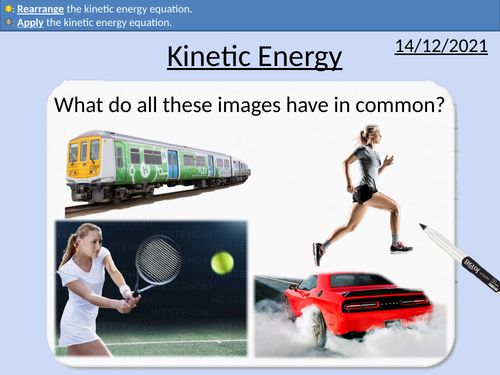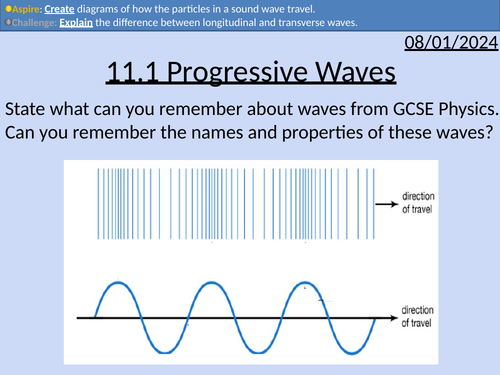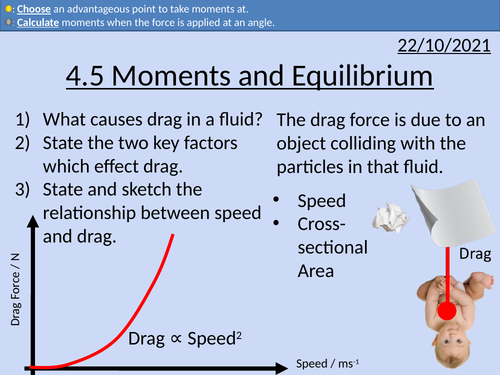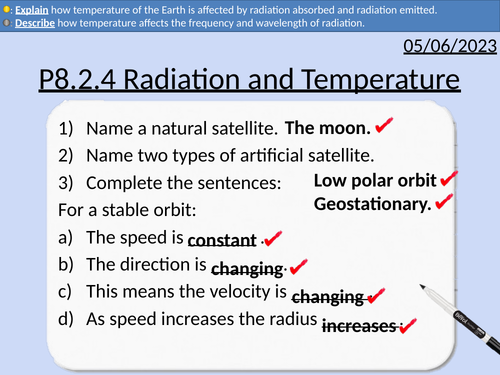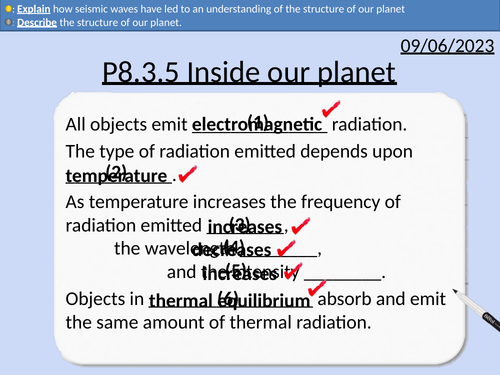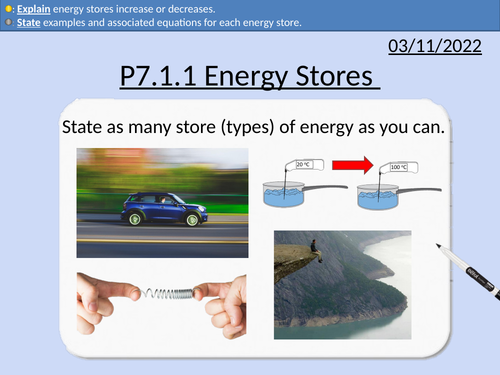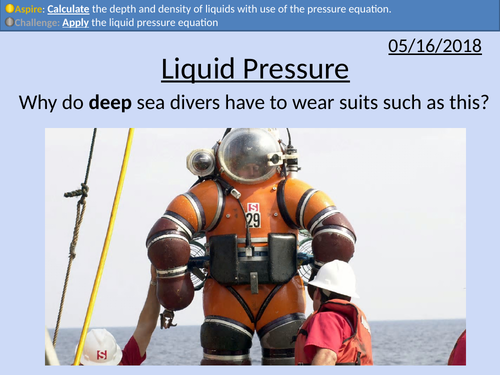484Uploads
146k+Views
64k+Downloads
Physics

GCSE Physics: Work Done and Power
This presentation covers OCR Gateway Physics 9-1 P2.2.7
Work done equation
Rearranging work done equation
Questions and answers for work done
Power equation and definition
Rearranging power equation
Different units for work done: J, N m, kg m^2/s^2

GCSE Physics: Stretching Springs
These two lesson presentations covers the OCR Gateway Physics 9-1 P2.3.1 material.
• Number of forces needed to deform an object
• Elastic and Plastic definitions
• Hooke’s Law
• Rearranging equations
• Determining the gradient
• Determining the spring constant
• Experimental procedure
• Exam style questions with solutions

GCSE Physics: Distance, Time and Speed
This presentation covers material for OCR Physics Gateway 9-1 P2.1.1
Covered:
Measuring and calculating
Accuracy of stop watch vs light gate
Conversion of units
Exam style question
Worked examples
Students questions with answers

GCSE Physics: Momentum
This presentation covers OCR Gateway Physics 9-1 P2.2.6
Momentum Equation
Rearranging the momentum equation
Momentum as a vector
Vector addition with momentum
Exam question with worked solutions
Student problems with answers
Proportionalities

GCSE Physics: Moments and Turning Forces
This presentation covers OCR Gateway Physics 9-1 P2.3.4 Turning Forces
Clockwise and anti-clockwise moments
Equation for moments
Rearranging equation
Balancing moments
Principle of moments

GCSE Physics: Hydraulic Systems
This presentation covers OCR Gateway Physics 9-1 P2.3.6 Hydraulic Systems
• Uses of hydraulics
• Pressure equation
• Rearranging equation
• Calculating pressure in liquids
• Describing how force multiplies in hydraulic systems
• Worked examples and student problems

OCR AS Physics: Intensity
OCR AS Physics A: Intensity is a part of the Module 4: Electrons, Waves, and Photons. PowerPoint with worked examples and homework.

GCSE Physics: Acceleration
This presentation covers OCR Gateway Physics 9-1 P1.2.3.
Content covered:
Definition for acceleration
Worked solutions
Students problems with answers
Exam style question with mark scheme

GCSE Physics: Kinetic Energy
This presentation covers OCR Gateway Physics 9-1 P2.1.6
Kinetic equation
Rearranging equations with three different methods.
Plotting velocity vs kinetic energy
Evaluating square relationships
Worked problems with solutions
Student problems with solutions

OCR AS level Physics: Progressive Waves
OCR AS level Physics: Progressive Waves is a part of the Module 4: Electrons, Waves, and Photons. PowerPoint with worked examples and homework.

OCR AS level Physics: Moments and Equilibrium
OCR AS level Physics: Moments and Equilibrium is a part of the Module 3: Forces and Motion
Presentation come with worked examples, solutions and homeworks.

GCSE Physics: Radiation and Temperature
This presentation covers OCR Gateway Physics 9-1 P8.3.4 Radiation and Temperature
This PowerPoint is a whole lessons included with student activities and animated answers.
All objects emit electromagnetic radiation
Describe how changing temperature changes frequency, wavelength, and intensity of the radiation produced.
Explain why objects change temperature by absorbing and emitting radiation.
Explain why the temperature of the Earth changes due to greenhouse gases in the atmosphere.

GCSE Physics: Inside our planet
This presentation covers OCR Gateway Physics 9-1 P8.3.5 Inside our planet
This PowerPoint is a whole lessons included with student activities and animated answers.
S and P waves
Structure of the Earth
Reflection, absorption, and refraction of waves
Sonar to map the ocean floor

GCSE Physics: Energy Stores
This presentation covers OCR Gateway Physics 9-1 P7.1.1 Energy stores
Examples, units, and equations of each energy store:
Kinetic
Gravitational potential
Elastic
Thermal
Magnetic
Electrostatic
Chemical
Nuclear
Student activities with full worked answers also included.

GCSE Physics: Energy Sources
This presentation covers OCR Gateway Physics 9-1 P8.2.1 Energy Sources
This PowerPoint is a whole lessons included with student activities and animated answers.
Types of different energy sources
Renewable and non-renewable definitions
Different uses of energy sources - transport, heating, and generating electricity
Advantages and disadvantages of different energy sources
Fossil fuels – oil, coal, and natural gas.
Nuclear fuel – Uranium
Biofuels – wood, biodiesel, and biogas.
The sun - solar (PV) panels and solar heating panels
Tides,
Waves,
Hydroelectricity
Wind
Geothermal

OCR AS level Physics: Free body diagrams
OCR AS level Physics: Free-body diagrams is a part of the Module 3: Forces and Motion
Presentation come with worked examples, solutions and homeworks.

GCSE Physics: Radiation and the body
This presentation covers OCR Gateway Physics 9-1 P6.2.1 Radiation and the body
This PowerPoint is a whole lessons included with student activities and animated answers.
Background radiation definition
Sources of background radiation
Contamination and irradiation
Medical examples of irradiation - X-rays, sterilisation, gamma knife
Medical examples of contamination - Tracers
Half-life and penetration power for radioactive tracers.

OCR AS Physics: Electromagnetic Waves
OCR AS Physics A: Electromagnetic Waves is a part of the Module 4: Electrons, Waves, and Photons. PowerPoint with worked examples and homework.

GCSE Physics: Liquid Pressure
This presentation covers OCR Gateway Physics 9-1 P1.3.4 Liquid Pressure
This presentation includes:
Liquid pressure equation
Worked solutions
Exam style questions with answers
Rearranging equations
Incompressibility of liquids.

OCR AS level Physics: Mean Drift Velocity
OCR AS level Physics: Mean Drift Velocity is a part of the Module 4: Electrons, Waves, and Photons.
Presentation come with worked examples, solutions and homeworks.
Number density for conductors, semi-conductors, and insulators
Calculating cross-sectional area
Apply the mean drift velocity equation.
Derivation of Mean Drift Velocity Equation









